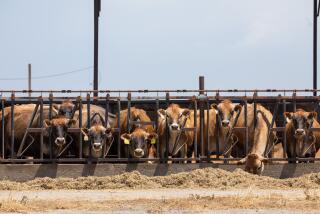Group pressures Foster Farms to address antibiotics
Foster Farms had just re-opened its main plant in Central California after a cockroach infestation, but federal inspectors were already writing-up new violations at the sprawling poultry-processing facility.
“I observed one carcass with visible fecal contamination,” a report dated Jan. 23 read. “The fecal material was olive green in color, pasty in texture.”
Later that morning, an inspector found a bin containing two carcasses contaminated with black “unidentified foreign material.”
U.S. Department of Agricultural inspectors would cite the Livingston, Calif., plant more than 40 times over the next two months for violations such as mold, rust on equipment and several instances of fecal contamination.
The new details were released by the Natural Resources Defense Council, a New York environmental advocacy group that is campaigning to reduce antibiotic use in livestock over concerns that it is contributing to drug-resistant superbugs.
The issue has become so prominent in the industry that Perdue Farms announced last week that it was the first major poultry brand to eliminate antibiotic use in its hatcheries.
Using the Freedom of Information Act, the NRDC received months’ worth of documented violations at Foster Farms from the USDA’s Food Safety and Inspection Service.
The goal? To lift the veil at a company linked to an outbreak of salmonella that sickened at least 634 people from March 2013 to July. The outbreak was notable for its higher rates of hospitalizations and the presence of antibiotic-resistant strains of salmonella.
“Throughout the salmonella crisis, Foster Farms repeatedly told us it was committed to leadership in food safety. But the reports show that when you look behind the curtain, it’s a company that can’t comply with its own food safety plan,” said Jonathan Kaplan, the council’s food and agriculture program director.
Foster Farms, the nation’s 10th largest poultry producer, said a lot has changed since the outbreak made national headlines and dropped company sales. It has worked closely with inspectors and consultants to drive salmonella rates down to less than 5% on raw chicken parts, well below the industry average of 25%.
“Foster Farms products in grocery stores today have been produced under the most stringent processes and are inspected and approved as wholesome, daily, by the USDA,” the company said.
“All Foster Farms products, as with all raw poultry products, are safe to consume when properly handled and fully cooked,” it said. “Experts agree that even with very low levels of salmonella incidence, the poultry industry cannot completely eliminate the risk of illness associated with raw poultry.”
Federal inspectors provided the NRDC documented violations from Sept. 30, 2013, to March 6. The reports show the company had been cited an average of once every two days at the Livingston facility. The reports detail nearly 500 violations across the company’s network of poultry plants, including those in Fresno and Washington state. Inspectors require violations to be corrected promptly.
Thomas E. Elam, president of farming consulting company FarmEcon in Carmel, Ind., said the number of violations was unusually high, though he did not have comparative data for poultry firms of a similar size.
“Some of the issues are very minor, but there is a pattern of lack of employee training and sanitation issues with the plant infrastructure that are not so minor,” said Elam, who reviewed a copy of the violations. “I’m frankly surprised by the number of bird handling and contamination issues from improperly operating equipment…. These data are not going to put Foster in a positive light.”
Elam said Foster Farms was probably under heavy scrutiny after the Food Safety and Inspection Service issued its health alert about the outbreak in October, 2013. That likely would have resulted in more reporting of violations, he said.
“It looks like Foster was trying to fix the issues without closing that plant, and it was not working,” Elam said. “Based on recent news, they have gotten the problem under control.”
Foster Farms said in June that it had reduced levels of salmonella to industry lows. They did it by introducing a multi-step program that includes vaccinating birds five times, chlorinating water and using acid litter and a probiotic feed that counters dangerous bacteria.
Still, the company issued its first recall during the outbreak the following month for chicken processed at its Livingston and two Fresno plants after a 10-year-old child was hospitalized by its poultry.
The Food Safety and Inspection Service did not respond to a request to explain whether Foster Farms was receiving violations at higher rates than similarly sized competitors.
Foster Farms said it has succeeded in reducing citations at its Livingston plant.
“Over the last three months, USDA inspectors have performed more than 4,800 tests in the areas of sanitation, [hazard prevention] and overall wholesomeness at the Livingston facility and have found Foster Farms to be 99% compliant,” the company said.
Kaplan of the NRDC said the list of violations underscores the need for Foster Farms to make the same commitments as Perdue to reduce antibiotics. Perdue, the nation’s fourth-largest poultry producer, said last week that 95% of its birds never receive any antibiotics that are also used in human medicine.
“When you take good care of animals and improve sanitation, you reduce the pressure from disease dramatically,” Kaplan said. “You don’t have to rely on a steady course of antibiotics to keep animals alive.”
Foster Farms said it only administers antibiotics when flocks are sick. It does not use the drugs for growth promotion or in its organic brand, Coastal Range Organics. Antibiotics are still administered in hatcheries for day-old chicks because they are vulnerable to bacteria, the company said.
About 80% of the antibiotics sold in the U.S. are used for farm animals. Critics said that has contributed to the diminished effectiveness of the drugs. More than 2 million people in the U.S. get infections that are resistant to antibiotics every year and at least 23,000 people die as a result, according to the Centers for Disease Control and Prevention.
Follow @dhpierson for more news on food and agriculture.
More to Read
Inside the business of entertainment
The Wide Shot brings you news, analysis and insights on everything from streaming wars to production — and what it all means for the future.
You may occasionally receive promotional content from the Los Angeles Times.











